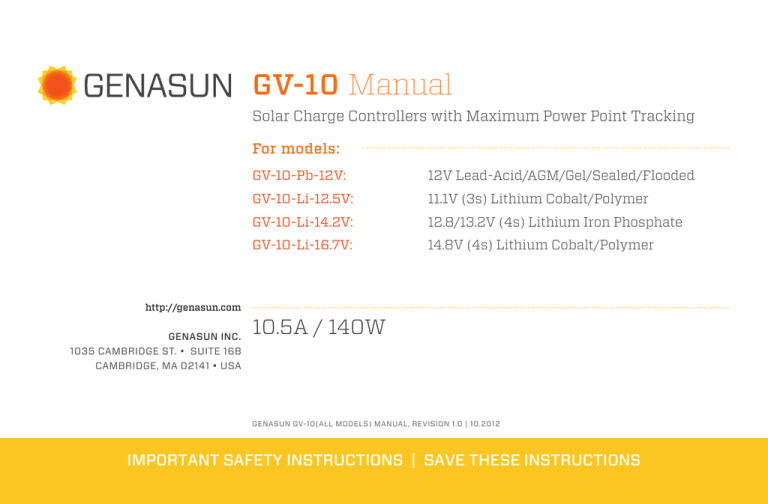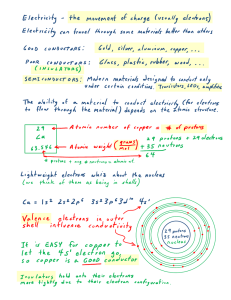
GV-10 Manual
Solar Charge Controllers with Maximum Power Point Tracking
For models:
http://genasun.com
Genasun Inc.
1035 Cambridge st. • Suite 16B
Cambridge, Ma 02141 • USA
GV-10-Pb-12V: 12V Lead-Acid/AGM/Gel/Sealed/Flooded
GV-10-Li-12.5V:
11.1V (3s) Lithium Cobalt/Polymer
GV-10-Li-14.2V:
12.8/13.2V (4s) Lithium Iron Phosphate
GV-10-Li-16.7V:
14.8V (4s) Lithium Cobalt/Polymer
10.5A / 140W
Genasun GV-10(all models) Manual, REVISION 1.0 | 10.2012
IMPORTANT SAFETY INSTRUCTIONS | SAVE THESE INSTRUCTIONS
Safety Instructions:
This manual contains important instructions for the GV-10-Pb-12V and GV-10-Li-**.*V solar charge controllers that shall be followed
during installation and maintenance. Various models of the GV-10 are available to charge different battery types as follows:
•
GV-10-Pb-12V: 12V Lead-Acid/AGM/Gel/Sealed/Flooded
•
GV-10-Li-12.5V:
11.1V (3s) Lithium Cobalt/Polymer
•
GV-10-Li-14.2V:
12.8/13.2V (4s) Lithium Iron Phosphate
•
GV-10-Li-16.7V:
14.8V (4s) Lithium Cobalt/Polymer
Consult your battery charging specifications to ensure that the GV-10 is compatible with your chosen batteries.
Carefully follow these instructions.
CAUTION for the GV-10-Pb-12V(Lead Acid Version Only):
INTERNAL TEMPERATURE COMPENSATION. RISK OF FIRE, USE WITHIN 0.3 m (1 ft) of BATTERIES. Lead-acid batteries can create
explosive gases. Short circuits can draw thousands of amps from a battery. Carefully read and follow all instructions supplied with
the battery. Use only 12V lead-acid batteries with the GV-10-Pb-12V.
DO NOT SHORT CIRCUIT the solar array when plugged into the controller. DO NOT MEASURE SHORT CIRCUIT CURRENT of the array
while connected to the controller. This will DESTROY the controller, and such damage will not be covered under warranty.
LITHIUM WARNING: Take caution when working with lithium systems. Genasun Li controllers use the CC/CV charging profile
indicated on the controller. CHECK the specifications of the battery pack to ensure that the CV voltage is correct. Further check that
the power supplied by the solar array and Genasun controller is within the battery specified design limits.
LITHIUM BMS WARNING: Genasun recommends using a lithium battery with a Battery Management System capable of
disconnecting the solar charge controller in the event that any cell in the pack is outside of its rated temperature, current, or
voltage range. Failure to do so may result in property damage, injury or death. Genasun highly recommends the use of a BMS with
cell balancing. Cell balancing is mandatory for lithium-iron phosphate systems.
Use only 10-30 AWG copper conductors suitable for a minimum of 60 degrees C. If operation at high power or at high ambient
temperatures is expected, wire with a higher temperature rating may be necessary.
Inspection & Maintenance
Inspect the controller at least once per year to ensure proper performance.
•
Check for animal or insect damage.
•
Inspect for corrosion / water damage.
•
Inspect the security of all connections.
•
Ensure the solar array does not exceed the maximum input voltage.
•
Repair and clean as necessary.
Installation & System Connections:
•
Connections should be made according to Article 690 of the National Electrical Code
(NFPA 70) or the standards in force at the installation location.
Electrical connections may be made in any order; however the sequence below is
recommended.
•
e
Battery
D
SelectING the battery type (Lead-Acid / Pb model only)
Your GV-10-Pb-12V controller is supplied set to the “SEALED” charging profile, which is appropriate for most
types of sealed lead-acid and gel batteries, as well as some types of AGM batteries. A “FLOODED” setting is
available for flooded batteries and other types of AGM batteries. The “FLOODED” setting includes equalization
charging. Please consult the specification table at the end of this manual to determine the best setting for
ia
g
m
ra
1
Panel
t CONNECTING THE SOLAR PANEL
Connect the solar panel to the +PANEL and –PANEL terminals. While connecting the battery first
will not damage the GV-10, we recommend connecting the panel first. This eliminates the risk of short-
Supplied
Jumper
circuiting the panel while the GV-10 is operating, which can cause damage.
• In most applications, the panel should be connected only to the GV-10.
No Jumper FOR NONFLOODED and sealed
BATTERIES.
• Do not use blocking diodes for single panel installations; they reduce system
performance with no benefit.
• Multiple panels may be connected in parallel up to the maximum power limit of the controller, with
ADD Jumper
FOR FLOODED
BATTERIES:
a blocking diode used for each panel (unless otherwise recommended by the panel manufacturer).
These panels should be the same model and facing the same direction, otherwise we recommend
your battery type. To change your GV-10 controller to the “FLOODED” setting, unscrew the four screws on the
using a separate controller for each panel.
bottom of the controller, remove the top, and install the supplied jumper on the 6 pin connector as shown in
• Solar panel voltage rises in cold weather. Check that the solar panel open circuit voltage (Voc)
diagram 1. Use care when installing the jumper, as incorrect installation can damage the controller. For sealed
will remain below the maximum input voltage of the GV-10 at the coldest possible expected
batteries, do not install the jumper.
temperature.
Note: In the GV-10, the negative side of the battery is connected internally to the negative side of the
r MOUNTING
solar panel.
Mount the controller near your battery securely using the holes provided on the enclosure’s flanges
or with a means appropriate to the application.
u CONNECTING THE BATTERY
• Mount near battery.
• The GV-10 can be mounted in any orientation.
Connect the battery to the +BATT and –BATT terminals.
• Do not expose to water.
• Do not mount in direct sunlight or near a source of heat.
• Allow adequate airflow around the controller to achieve maximum output capability.
• For outdoor use, the controller must be housed in an enclosure providing protection
at least equivalent to NEMA Type 3.
Note: Make sure to inspect the controller at least once
per year to ensure proper performance. Please see the
Inspection & Maintenance section in this guide.
The GV-10 has a
Multicolor LED.
Learn about this indicator
on the following page.
• A small spark while connecting the battery is ok.
• Any loads should be connected directly to the battery. The GV-10 does not provide
protection against over-discharge.
Status Indication:
The GV-10 has a Multicolor LED
LED Run/Charge Indication
Standby: The battery is connected properly and ready to charge
when solar panel power is available.
2 sec. between Green blinks
Charging (low current, less than ~3.7A):
Fast & short Green blinks
Charging (high current, more than ~3.7A):
longer Green blinks
Charging (current limit): charging at current limit (10.5A+).
Long, then short Green blinks
Battery Charged: The battery is in the absorption
or float charging stage.
Solid Green LED
LED Error Indication
Troubleshooting
Overheat: The controller’s internal temperature is too high.
If the LED indicator does not light, check that there is battery voltage present on the GV-10 battery terminals. The GV-10 will not operate without a
sets of 2 red blinks.
Overload: This could be caused by changing the solar
panel connections while the controller is operating.
sets of 3 red blinks.
Battery voltage too low: The controller cannot begin
charging due to low battery voltage. If the nominal battery
battery. If there is battery voltage present, check the fuse inside the GV-10 by removing the four screws on the bottom of the enclosure. If the fuse is
blown, replace it with a 20A fast-acting ATO or ATC fuse rated 32V or higher.
The most common causes of blown fuses are:
• Connecting the GV-10 to the battery backwards
• Shorting the solar panel input while the GV-10 is charging
• Connecting the GV-10 battery terminals to a 24V battery
In the latter two cases, there may be other internal damage to the controller.
voltage is correct (12V), charge the battery by some other
means before use.
sets of 4 red blinks
Battery voltage too high: If the nominal battery voltage is
correct (12V), check the functioning of other chargers that
may be connected to the system.
sets of 5 red blinks.
Panel voltage too high: Only 12V nominal solar panels may
be used with this controller.
sets of 6 red blinks.
Internal Error: Contact your dealer for assistance.
2 Long Blinks, followed by any number
of short blinks.
Copyright © 2012 Genasun. All rights reserved. Changes are periodically made to the information herein which will be
incorporated in revised editions of this publication. Genasun may make changes or improvements to the product(s)
described in this publication at any time and without notice.
Specifications:
GV-10-Pb-12V
120W
GV-10-Li-**.*V
GV-10-Li-12.5V
10.5A
140W
10.5A
N/A
GV-10-Li-14.2V
Rated Battery (Output)
Current:
12V
34V
140W
Nominal Battery Voltage:
34V
27V
160W
Max Panel Voltage (Voc):
27V
8.5V
GV-10-Li-16.7V
Recommended Max Voc
at STC:
8.5V
CC-CV
Maximum Recommended
Panel Power:
Minimum Battery Voltage
for Operation:
Multi-Stage with
Temperature
Compensation
Charge Profile:
–
Charging Voltages:
–
–
–
–
SEALED
Setting
2 Hours
–
–
15.0V
Equalization Time:
30 Days
14.3V
–
FLOODED
Setting
Equalization Interval:
14.6V
14.1V
Equalization Voltage:
Bulk Voltage:
14.4V
–
–
12.5V
-40°C – 85°C
14.2V
-28mV/°C
96% - 98% typical
GV-10-Li-12.5V
-40°C – 85°C
99+% typical
GV-10-Li-14.2V
96% - 98% typical
15Hz
13.7V
99+% typical
0.9mA (900uA)
16.7V
15Hz
GV-10-Li-16.7V
Electrical Efficiency:
0.9mA (900uA)
Yes
13.5V
2.5 Hours
Absorption Voltage:
Absorption Time:
Float Voltage (Pb models)
or CV Voltage (Li models):
Tracking Efficiency:
Yes
Battery Temperature
Compensation:
Marine Grade:
Night Consumption:
MPPT Tracking Speed:
Operating Temperature:
Connection:
6.5oz., 185g
5.5x2.5x1.2”, 14x6.5x3.1cm
4-position terminal block for
10-30AWG wire
5.5x2.5x1.2”, 14x6.5x3.1cm
5 years
6.5oz., 185g
5 years
4-position terminal block
for 10-30AWG wire
Weight:
Dimensions:
Warranty:


